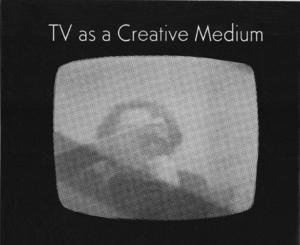Difference between revisions of "TV as a Creative Medium"
(Created page with "Electronic video work exhibition, which took place in New York in 1969 and featured work by Nam June Paik, Frank Gillette, Ira Scheider and Eric Siegel. http://...") |
|||
| (One intermediate revision by the same user not shown) | |||
| Line 1: | Line 1: | ||
| − | + | [[Image:TV_as_a_Creative_Medium_1969.png|thumb|300px|''TV as a Creative Medium'', New York, 1969, [[Media:TV_as_a_Creative_Medium_1969.pdf|PDF]].]] | |
| + | '''TV as a Creative Medium''' was an exhibition of electronic video works that took place from 17 May to 17 June 1969 at the [[Howard Wise Gallery]] in [[New York]]. | ||
| − | http://www.eai.org/kinetic/ch1/creative.html | + | This seminal exhibition heralded a burgeoning development that came to be known as [[video art]]. The first exhibition in the United States devoted to video, ''TV as a Creative Medium'' signaled radical changes, inspiring a generation of artists to take up video and provoking commentary that extended well beyond the channels of art discourse. Among the twelve artists in the show were [[Nam June Paik]], [[Charlotte Moorman]], [[Paul Ryan]], [[Ira Schneider]], [[Frank Gillette]], and [[Eric Siegel]]. Prescient in its diversity, the exhibition featured performance, objects, closed-circuit tapes and installations, with works as varied as Paik and Moorman's ''TV Bra for Living Sculpture'', Gillette and Schneider's ''Wipe Cycle'' and Thomas Tadlock's ''Archetron''. [http://www.eai.org/webpages/1004] |
| + | |||
| + | ; Publications | ||
| + | |||
| + | * ''[[Media:TV_as_a_Creative_Medium_1969.pdf|TV as a Creative Medium]]'', New York: Howard Wise Gallery, 1969, [8] pp. Reviews: [https://www.eai.org/supporting-documents/183/w.1164.0 Yalkut] (Arts), [https://www.eai.org/supporting-documents/186/w.1164.0 Time], [[Media:Skidmore Richard 1969 TV as Art.pdf|Skidmore]], [https://www.eai.org/supporting-documents/185/w.1164.0 Harrington] (Village Voice). Commentaries: [[#Margolies1969|Margolies]] (Arts in America, 1969), [[#Sturken1984|Sturken]] (Afterimage, 1984). [http://www.eai.org/webpages/1001 EAI resource]. | ||
| + | |||
| + | * Marita Sturken, [[Media:Sturken Marita 1984 TV as a Creative Medium Howard Wise and Video Art.pdf|"TV as a Creative Medium: Howard Wise and Video Art"]], ''Afterimage'' 11:10, May 1984, pp 5-9, [http://vasulka.org/Kitchen/essays_sturken/K_SturkenWise_01.html HTML]. | ||
| + | |||
| + | ; Links | ||
| + | * https://web.archive.org/web/20070608181737/https://www.eai.org/kinetic/ch1/creative.html | ||
| + | * http://www.eai.org/webpages/1004 | ||
| + | |||
| + | [[Series:Video art]] | ||
Latest revision as of 16:42, 5 April 2025

TV as a Creative Medium was an exhibition of electronic video works that took place from 17 May to 17 June 1969 at the Howard Wise Gallery in New York.
This seminal exhibition heralded a burgeoning development that came to be known as video art. The first exhibition in the United States devoted to video, TV as a Creative Medium signaled radical changes, inspiring a generation of artists to take up video and provoking commentary that extended well beyond the channels of art discourse. Among the twelve artists in the show were Nam June Paik, Charlotte Moorman, Paul Ryan, Ira Schneider, Frank Gillette, and Eric Siegel. Prescient in its diversity, the exhibition featured performance, objects, closed-circuit tapes and installations, with works as varied as Paik and Moorman's TV Bra for Living Sculpture, Gillette and Schneider's Wipe Cycle and Thomas Tadlock's Archetron. [1]
- Publications
- TV as a Creative Medium, New York: Howard Wise Gallery, 1969, [8] pp. Reviews: Yalkut (Arts), Time, Skidmore, Harrington (Village Voice). Commentaries: Margolies (Arts in America, 1969), Sturken (Afterimage, 1984). EAI resource.
- Marita Sturken, "TV as a Creative Medium: Howard Wise and Video Art", Afterimage 11:10, May 1984, pp 5-9, HTML.
- Links